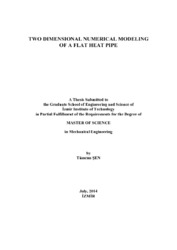Please use this identifier to cite or link to this item:
https://hdl.handle.net/11147/4233Full metadata record
| DC Field | Value | Language |
|---|---|---|
| dc.contributor.advisor | Özkol, Ünver | - |
| dc.contributor.author | Şen, Tümcan | - |
| dc.date.accessioned | 2014-12-04T12:56:45Z | - |
| dc.date.available | 2014-12-04T12:56:45Z | - |
| dc.date.issued | 2014-07 | - |
| dc.identifier.uri | http://hdl.handle.net/11147/4233 | - |
| dc.description | Thesis (Master)--Izmir Institute of Technology, Mechanical Engineering, Izmir, 2014 | en_US |
| dc.description | Includes bibliographical references (leaves: 80-82) | en_US |
| dc.description | Text in English; Abstract: Turkish and English | en_US |
| dc.description | Full text release delayed at author's request until 2017.07.17 | en_US |
| dc.description.abstract | In this study, a flat heat pipe with asymmetric boundary conditions is modeled numerically in two-dimensional space. Vapor and wick regions are incorporated in the analysis. The Navier-Stokes equations along with the energy equation are solved under steady state, subsonic, laminar, incompressible and Newtonian flow assumptions. Furthermore, Brinkman-Forchheimer extended Darcy model is employed for the liquid flow in the wick structure. SIMPLE algorithm is employed with staggered grid arrangement to overcome the complications caused by the pressure terms in the momentum equations. The model accounts for uniform injection and suction in the evaporator and condenser sections and it is assumed that evaporation and condensation only occur in evaporator and condenser sections, respectively. Wick structure is presumed to be isotropic and saturated with working fluid. All thermo physical properties are taken as constant and no body forces are included in the model. By considering all of the above information, an in-house code is developed by using the software, MATLAB in order to perform the analysis. The major results introduced are the distribution of velocity components along with their profiles at different locations, temperature distribution and pressure drops along the heat pipe as well as their distributions within the domain. Additionally, parametric analyses are performed to investigate the effects of heat input and heat pipe aspect ratio on the required capillary pressure. | en_US |
| dc.language.iso | en | en_US |
| dc.publisher | Izmir Institute of Technology | en_US |
| dc.rights | info:eu-repo/semantics/openAccess | en_US |
| dc.subject | Flat heat pipe | en_US |
| dc.subject | Numerical modeling | en_US |
| dc.subject | Staggered grid | en_US |
| dc.subject | SIMPLE algorithm | en_US |
| dc.title | Two Dimensional Numerical Modeling of a Flat Heat Pipe | en_US |
| dc.title.alternative | Düzlemsel Bir Isı Borusunun İki Boyutlu Nümerik Modellenmesi | en_US |
| dc.type | Master Thesis | en_US |
| dc.institutionauthor | Şen, Tümcan | - |
| dc.department | Thesis (Master)--İzmir Institute of Technology, Mechanical Engineering | en_US |
| dc.relation.publicationcategory | Tez | en_US |
| dc.identifier.wosquality | N/A | - |
| dc.identifier.scopusquality | N/A | - |
| item.languageiso639-1 | en | - |
| item.grantfulltext | open | - |
| item.fulltext | With Fulltext | - |
| item.openairecristype | http://purl.org/coar/resource_type/c_18cf | - |
| item.openairetype | Master Thesis | - |
| item.cerifentitytype | Publications | - |
| crisitem.author.dept | 01. Izmir Institute of Technology | - |
| Appears in Collections: | Master Degree / Yüksek Lisans Tezleri | |
Files in This Item:
| File | Description | Size | Format | |
|---|---|---|---|---|
| 10012904.pdf | MasterThesis | 5.13 MB | Adobe PDF |  View/Open |
CORE Recommender
Page view(s)
306
checked on Jun 16, 2025
Download(s)
226
checked on Jun 16, 2025
Google ScholarTM
Check
Items in GCRIS Repository are protected by copyright, with all rights reserved, unless otherwise indicated.